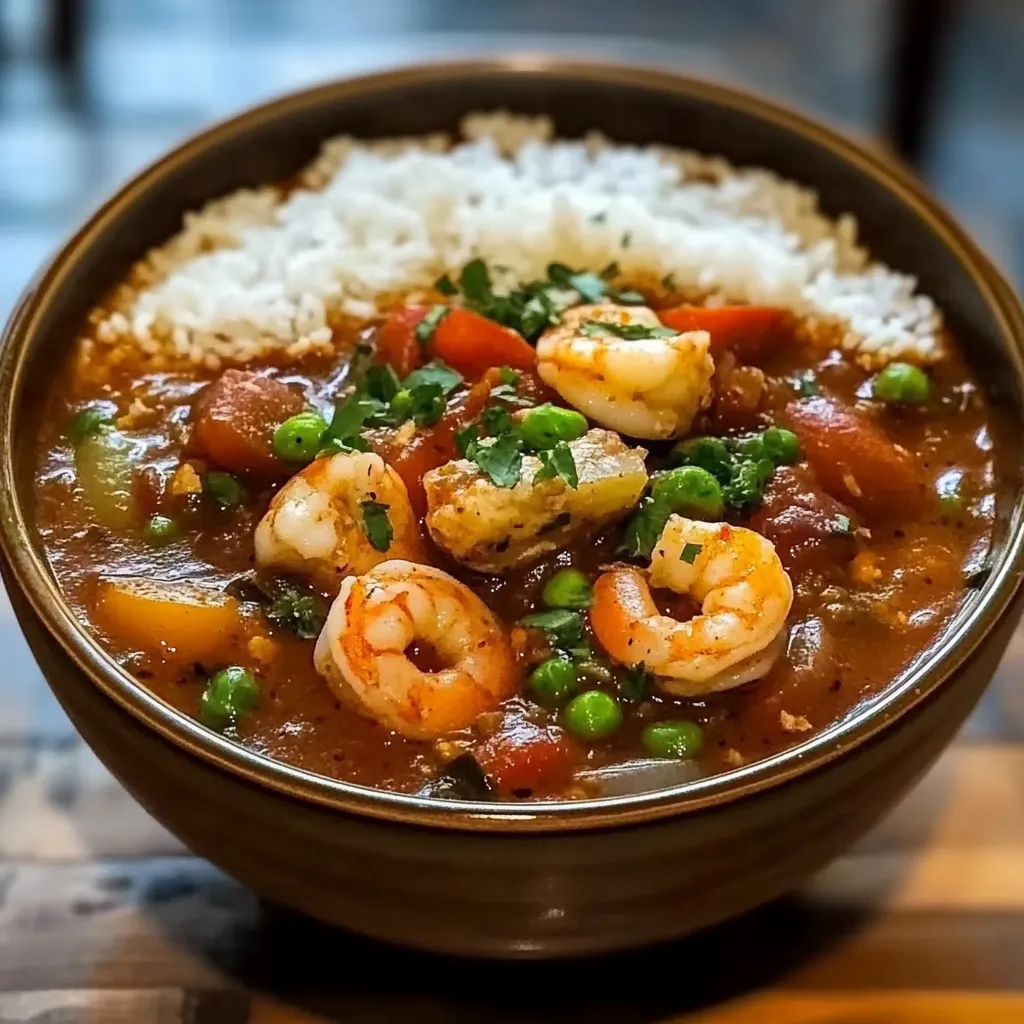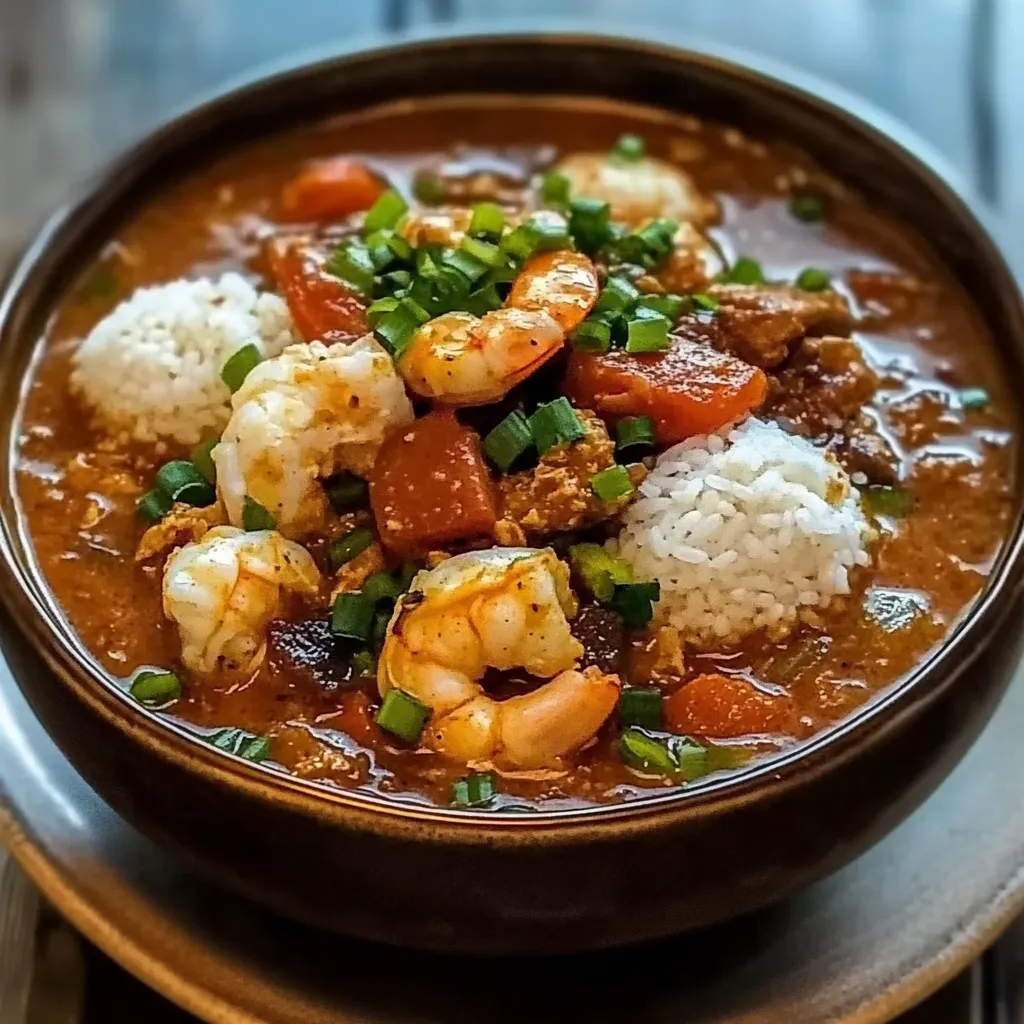Louisiana Seafood Gumbo: A Taste of Louisiana’s Best

There’s something undeniably comforting about a warm, steaming bowl of Louisiana Seafood Gumbo. As a hallmark of Creole cuisine, this hearty dish brings together succulent seafood, robust spices, and a deep flavor profile that dances on the palate. Whether you’re drawn to the rich umami of shrimp and crab or the earthiness of andouille sausage, there’s a perfect version awaiting your interpretation. You can customize this dish to your liking, experimenting with various ingredients like okra for thickness or a hint of hot sauce for a spicy kick.
For those looking to master the art of gumbo, don’t overlook the significance of a well-made roux—this is often the cornerstone of the dish’s robust flavor. Patience is key as you stir it to a deep caramel color. With a handful of expert tips and creative twists, you’ll be able to achieve your own signature take on this Louisiana classic!
Ingredients for Louisiana Seafood Gumbo:
Essential Ingredients
- 1/2 cup vegetable oil
- 1/2 cup all-purpose flour
- 1 medium onion, finely chopped (about 1 cup)
- 1 medium green bell pepper, finely chopped (about 1 cup)
- 1 medium celery stalk, finely chopped (about 1 cup)
- 4 cloves garlic, minced
- 6 cups low-sodium chicken broth
- 2 cups okra, sliced (fresh or frozen)
- 1 lb andouille sausage, sliced into rounds
- 1 lb shrimp, peeled and deveined
- 1 lb crab meat, picked through for shells
- 2 cups mussels, cleaned (optional)
- 1 tablespoon Worcestershire sauce
- 2 teaspoons liquid hot sauce (adjust to taste)
- 2 bay leaves
- 1 teaspoon dried thyme
- 1 tablespoon Creole seasoning
- Salt and black pepper to taste
- Cooked white rice, for serving
- Chopped green onions, for garnish
- Fresh parsley, chopped (for garnish)
What to Consider for Flavor Variations
- Seafood Variety: Instead of shrimp and crab, consider using fish fillets (like catfish) or adding scallops for a different taste experience.
- Seasoning Enhancements: You might explore adding a pinch of cayenne pepper for additional heat or using smoked paprika to create a smoky depth in your gumbo.
- Herb Options: Fresh herbs like thyme or bay leaf can be substituted with dried versions, but fresh herbs can enhance the flavor profiles significantly.
- Vegetable Additions: If you want to pack in more vegetable nutrition, consider including diced tomatoes or bell peppers in various colors for added sweetness and visual appeal.
Garnishes to Elevate Your Gumbo
- Lemon Wedges: Squeezing a little lemon over the dish before serving can brighten the flavors.
- Tabasco Sauce: A few drops can appeal to those who love a spicy kick.
- Cornbread or French Bread: Serve along the gumbo for a hearty accompaniment.

How to prepare Louisiana Seafood Gumbo:
Cooking Louisiana Seafood Gumbo requires several key steps to ensure a rich and flavorful dish. Follow these instructions closely.
Gather Your Ingredients
Start by collecting all your ingredients. You need okra, shrimp, crab, and sausage, as well as a variety of spices and vegetables. Fresh herbs will enhance the flavor.
Create the Base with Roux
In a heavy-bottomed pot, add equal parts vegetable oil and flour over medium heat. Stir continuously to create a roux.
Cook the roux until it turns a deep brown color, resembling chocolate. This process usually takes about 20-30 minutes.
Add Vegetables for Flavor
Once the roux reaches the right color, add chopped onions, bell peppers, and celery. These three vegetables, known as the “Holy Trinity” in Cajun cooking, will infuse essential flavors.
Stir the mixture for about 5 minutes to soften the vegetables.
Incorporate Aromatics
Add minced garlic and diced tomatoes to the pot. Continue cooking for another 2-3 minutes, allowing the flavors to meld.
Add Broth and Seasonings
Pour in your seafood or chicken broth gradually, scraping the bottom to lift any dark bits. This enhances the overall taste.
Then, season the pot with bay leaves, thyme, salt, black pepper, and cayenne pepper. Mix well.
Introduce the Proteins
Now it’s time to add your protein. Start with sausage, cooking for about 10 minutes.
Next, include the shrimp and crab. If you are using raw seafood, ensure they cook through, which usually takes about 5-7 minutes.
Add Okra for Thickness
Add sliced okra to the gumbo. This ingredient not only thickens the dish but also adds a unique texture.
Allow everything to simmer for about 30 minutes, stirring occasionally.
Final Touches and Serve
Before serving, remove the bay leaves and adjust the seasonings if needed. Serve the gumbo hot over steamed rice.
Garnish with chopped green onions or fresh parsley for an inviting presentation. Enjoy your homemade culinary masterpiece!
Tips for the Perfect Louisiana Seafood Gumbo
Maintain the Right Temperature
Cooking gumbo requires patience. Start by making a dark roux. Heat your oil slowly over medium to medium-low heat. Stir frequently until it reaches the desired color—dark chocolate brown. This step is crucial because it deeply flavors your dish. Avoid rushing this process; if the roux burns, you’ll need to start over. After adding the vegetables, continue to cook on low heat. Simmering gently allows the flavors to meld beautifully.
Use Quality Ingredients for Authentic Flavor
The key to a delicious gumbo lies in using fresh and quality ingredients. Opt for shrimp, crab, or other seafood that is fresh or properly frozen. If possible, buy from local seafood markets. Fresh herbs, like thyme and parsley, elevate the taste significantly. Think about using homemade stock instead of store-bought for deeper flavor. Your choice of sausage also impacts the dish. Andouille sausage adds an authentic kick, but you can use smoked sausage if you’re seeking alternatives.
Suitable Substitutions for Dietary Restrictions
To accommodate dietary needs, you can modify the seafood gumbo recipe. If someone is allergic to shellfish, substitute the shrimp and crab with chicken or fish, like cod. For a vegetarian version, consider using vegetable broth and a mix of seasonal vegetables. Mushrooms can mimic the umami flavor that seafood provides. If you want a gluten-free option, ensure your roux uses gluten-free flour, or skip this step and rely on thickening with okra or filé powder.
Tips for Adding Extra Flavor
To achieve deeper flavor profiles, consider adding a splash of Worcestershire sauce or a few dashes of hot sauce right before serving. These ingredients can enhance the gumbo without overpowering it. Additionally, letting the gumbo sit for a few hours or overnight in the fridge allows the flavors to develop further. Reheat it gently to preserve the quality and taste.
By applying these tips, you can create a delicious Louisiana Seafood Gumbo that everyone will love. Happy cooking!
Storage Tips for Louisiana Seafood Gumbo:
Maintain Freshness with Proper Cooling
To keep your gumbo fresh, cool it down quickly after cooking. Place the pot in a sink filled with ice water for about 30 minutes. Stir occasionally to help it cool evenly. Once it reaches room temperature, portion the gumbo into smaller airtight containers for easy storage. Always avoid leaving cooked food at room temperature for more than two hours, as this can promote bacterial growth.
Optimal Storage Conditions for Gumbo
Store your portions in the refrigerator if you plan to eat the gumbo within three to four days. Make sure your refrigerator temperature stays at or below 40°F (4°C). For longer storage, consider freezing the gumbo. Use freezer-safe containers or heavy-duty freezer bags. Remove as much air as possible before sealing—I recommend using a straw to suction out extra air from bags.
Shelf Life of Gumbo
When stored properly in the refrigerator, your gumbo will stay fresh for about three to four days. If you choose to freeze it, the gumbo can last for up to six months without losing taste and texture. Properly labeled containers or bags also help prevent freezer burn. Write the date, so you know when to use it by.
Reheating Tips for Best Flavor
When ready to enjoy your stored gumbo, reheat only the amount you plan to eat. Use a pot on the stove for even heating. Stir occasionally to avoid hot spots. If microwave reheating, place the gumbo in a microwave-safe bowl and cover it loosely with a microwave-safe lid or plate. Heat in short intervals and stir in between. The gumbo should reach an internal temperature of 165°F (74°C) for safe consumption.
Thawing Frozen Gumbo
To thaw your gumbo, transfer it from the freezer to the refrigerator a day before you plan to eat it. If you’re short on time, you can also defrost it in the microwave using the defrost setting. Avoid thawing at room temperature to maintain quality and safety.
These simple tips help keep your Louisiana seafood gumbo fresh longer while ensuring your next meal will be just as delicious as the first.
Related Recipes to Enhance Your Culinary Journey
If you enjoyed Louisiana Seafood Gumbo, you’ll appreciate these related recipes that share similar ingredients, flavors, or cooking techniques. Each dish brings a unique twist while maintaining that rich, comforting essence of Southern cuisine.
1. Shrimp Etouffee
Shrimp Etouffee is a delectable option that features succulent shrimp simmered in a thick, flavorful sauce made from a dark roux, onions, bell peppers, and celery—often referred to as the “holy trinity” of Cajun cooking. This dish offers a creamy texture and a hint of spice, making it a perfect companion to gumbo. Serve it over rice for a satisfying meal.
2. Cajun Jambalaya
Jambalaya serves as a hearty, one-pot dish that showcases the vibrant flavors of Cajun and Creole cooking. It includes a mix of shrimp, sausage, and sometimes chicken, cooked together with rice and aromatic vegetables. The bold spices and smoky undertones resonate beautifully with the essence of gumbo, creating a harmonious dinner option.
3. Seafood Po’ Boy
The Seafood Po’ Boy sandwich features crispy, fried seafood, such as shrimp or oysters, tucked inside a soft French roll. It’s often dressed with lettuce, tomatoes, and a spicy remoulade. This dish pairs well with gumbo, as both highlight the bounty of the sea, allowing you to explore different textures and tastes within your meal spread.
4. Crawfish Étouffée
For something unique yet familiar, Crawfish Étouffée delivers rich flavors and a comforting experience. Using crawfish instead of shrimp adds a new layer of taste, while the classic roux and vegetable medley create that same deep flavor profile typical of gumbo.
These recipes complement each other, making them perfect additions to your culinary repertoire. By incorporating these dishes, you can create a Southern feast that highlights the best of seafood while celebrating diverse cooking methods.
Frequently Asked Questions:
What is Louisiana Seafood Gumbo?
Louisiana Seafood Gumbo is a rich, flavorful stew that has its roots deeply embedded in Creole and Cajun cuisine. This hearty dish typically features a combination of fresh seafood, such as shrimp, crab, and fish, cooked in a thick, seasoned broth. It’s often thickened with a roux, a mixture of flour and fat, which gives gumbo its characteristic depth and complexity. Served over rice, this delicious meal is a staple in New Orleans and throughout Louisiana.
How can I make a traditional gumbo at home?
Making a classic gumbo at home involves several key steps. Start by preparing a dark roux, cooking flour and oil together until it reaches a deep brown color. Then, sauté vegetables like onions, bell peppers, and celery, known as the “holy trinity” of Cajun cooking. Add your choice of seafood, seasonings, and broth to the mix, and let it simmer for a couple of hours. Finally, serve it hot over a bed of rice for a comforting meal that’s bursting with flavor.
What seafood is best for gumbo?
When it comes to creating delightful seafood gumbo, incorporating a variety of options can elevate the dish. Common choices include shrimp, crab, and oysters. You can also experiment with fish like catfish or tilapia for added texture. The key is to use fresh seafood that complements the robust flavors of the stew, allowing the natural sweetness of the seafood to shine through.
Can I prepare gumbo in advance?
Definitely! In fact, many chefs believe that gumbo tastes even better the day after it’s made, as the flavors have more time to meld together. You can prepare the gumbo in advance and refrigerate it for up to three days. For longer storage, consider freezing it in an airtight container, which allows you to enjoy the dish later while maintaining its delicious taste.
What can I serve with gumbo?
Louisiana Seafood Gumbo is often enjoyed with rice, which soaks up the flavorful broth beautifully. Additionally, it pairs well with crusty French bread or cornbread, making for a satisfying meal. For a complete dining experience, consider serving a fresh salad or a side of pickled vegetables to balance the richness of the stew.
Is gumbo gluten-free?
Traditional recipes often use flour in the roux, making gumbo unsuitable for those with gluten sensitivities. However, you can make a gluten-free version by substituting the flour with rice flour or cornstarch. This allows you to retain the same delightful flavor and texture without compromising on dietary restrictions.
Conclusion:
Creating a delicious pot of Louisiana Seafood Gumbo is both simple and rewarding. With a few basic ingredients like seafood, vegetables, and the essential roux, you can whip up a flavorful dish that embodies the spirit of Louisiana cuisine. This recipe is highly flexible; you can easily swap in your favorite seafood or adjust the spice level to suit your palate. Customization options abound—whether you prefer a thicker consistency or a heartier protein combination, the choice is yours. Embrace the essence of this classic dish and let your creativity shine in the kitchen. Louisiana Seafood Gumbo is not just a meal; it’s a celebration of flavors that brings friends and family together. Enjoy the process and make it your own!
Print
Louisiana Seafood Gumbo: A Taste of Louisiana’s Best
- Total Time: 1 hour
- Yield: 6 servings 1x
Description
🍤 Louisiana Seafood Gumbo: A Taste of Louisiana’s Best
This soul-warming seafood gumbo is loaded with shrimp, crab, and okra simmered in a dark, flavorful roux and classic Cajun spices. It’s a Southern staple that brings the taste of Louisiana straight to your kitchen!
Ingredients
-
½ cup vegetable oil
-
½ cup all-purpose flour
-
1 large onion, chopped
-
1 bell pepper, chopped
-
2 celery stalks, chopped
-
3 cloves garlic, minced
-
1 tsp Cajun seasoning
-
1 tsp paprika
-
½ tsp dried thyme
-
1 bay leaf
-
1 (14 oz) can diced tomatoes
-
4 cups seafood or chicken broth
-
1 lb raw shrimp, peeled and deveined
-
1 cup lump crab meat (or imitation crab)
-
2 cups sliced okra (fresh or frozen)
-
Salt and pepper to taste
-
Cooked white rice, for serving
-
Chopped green onions & parsley, for garnish
Instructions
-
Make the roux: In a large pot, heat oil over medium heat. Stir in flour and cook, stirring constantly, until the mixture turns a deep brown color (about 15–20 minutes).
-
Sauté the veggies: Add onion, bell pepper, celery, and garlic to the roux. Cook until soft, about 5 minutes.
-
Add seasoning & broth: Stir in Cajun seasoning, paprika, thyme, bay leaf, tomatoes, and broth. Simmer for 20 minutes.
-
Add seafood & okra: Stir in shrimp, crab, and okra. Cook until shrimp is pink and fully cooked (about 5–7 minutes).
-
Finish: Remove bay leaf. Season with salt and pepper to taste. Serve hot over rice and garnish with green onions and parsley.
Notes
-
Use fresh Gulf seafood for the most authentic flavor.
-
To deepen flavor, simmer the base longer before adding seafood.
-
You can substitute or add sausage for a heartier twist.
- Prep Time: 15 minutes
- Cook Time: 45 minutes
Nutrition
- Calories: 390
- Sugar: 4g
- Sodium: 780mg
- Fat: 22g
- Saturated Fat: 3g
- Carbohydrates: 20 g
- Fiber: 3g
- Protein: 28g
